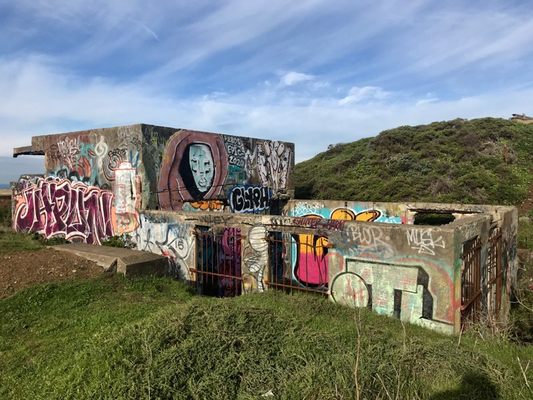About
You might not expect to find WWII pillboxes, anti-aircraft gun mounts, and missile launch sites among the rolling hills and wetlands of the Marin Headlands, but at one time this was a highly fortified military defensive position.
The hills overlooking the Golden Gate Bridge are riddled with bunkers, secret tunnels, and batteries designed to protect San Francisco from attack from as early as the Civil War period. On the Marin (North) shore there are three forts and several attack positions.
Directly overlooking the Golden Gate Bridge, Battery Spencer actually predates the bridge significantly. Started in 1893 and connected to the nearest town by dangerous cliffside roads, the Battery was constructed as part of the overall fortification efforts known as the Endicott Period. President Grover Cleveland with his War Secretary William Endicott set out on a massive building and modernization project at 29 locations around the country, costing some $127 million in construction costs. Battery Spencer was constructed of concrete set into the cliffside and housed three M1888 12" guns, including one aimed into the harbor mouth, as well as ammunition storage and support buildings. During WWI guns and ammunition were relocated to support the war effort, and in 1943 the remaining guns were scrapped to support that new war effort, effectively ending the life of the battery. Today, the buildings and gun mounts are deserted, but in good repair, painted a drab green, and surrounded by well manicured trails.
Fort Barry and Bunker Road were also built up during the Endicott Period. There are five seperate batteries that are part of Fort Barry: Battery Mendell, Battery Alexander, Battery Smith-Guthrie, Battery Samuel Rathbone and Battery Patrick O’Rorke. The batteries are well hidden in undergrowth, and features the latest in turn of the century "disappearing carriage" technology, including guns that would raise up to fire, and then lower to a safer reloading position after discharge. These batteries remained active through WWII, upgraded with anti-aircraft weapons.
Fort Cronkhite and Battery Townsend are more recent additions, built as part of the Harbor Defense initiatives in WWII. Located farther out along the coast, they look out onto the open waters outside the Golden Gate. The fort's barracks, mass halls and support buildings now house park support staff and other businesses, but are preserved in an original state.
Up the hill from Fort Cronkhite, Battery Townsend has some of the most impressive buildings. The construction of the batteries was secret, and designed to be hidden from view. Concrete behemoths are dug into the hillside, with only a modest tunnel entrance on one side, but a gaping maw surrounding a gun mount facing the water at the other end. Designed to acommodate two 16-inch caliber guns shooting armor piercing projectiles that reached more than 30 miles out to sea (past the Farallon Islands, visible in the distance), it was the first ever of its kind. Tests of the new guns in 1940 were a success, and plans were made to imitate the design along the coastline.
Overlooking all of it is Hill 88, which can be reached by hiking trails. Originally a surveillence sight constructed on high where fog and cloud cover would obscure it from view, now it is a concrete ruin like all the rest. Graffiti-covered military ruins drifting in and out of view in the fog makes for a surreal, post-apocalyptic vibe - especially since the steep hike up there often means you have the whole place to yourself. While the complex is not more than 25 or so structures, the frequent dense fog cover makes exploring the ruins feel like you're wandering in a place that is much, much larger.
The Cold War saw the addition of another super-secret military installation, the Nike Missile Base SF-88. Installed between 1953 and 1979 the anti-aircraft missiles were intended to fend off soviet fighters. It is now the only intact Nike base in the US open to the public.
All of the forts and batteries can be visited by driving the roads on the Headlands. The paths are maintained and there is good signage, however the weather along the coast can be extremely gusty and/or foggy and the cliffs can be extremely dangerous, so explore with caution.
Related Tags
Know Before You Go
The batteries and forts are spread over several miles of relatively well marked roads. Directions will get you off the freeway and onto the headlands roads.
From San Francisco: Cross the Golden Gate Bridge, take the Alexander Avenue exit (second after the bridge). Stay right to get onto Alexander Ave, turn left on Bunker Road.
From Marin: Take the last Sausalito exit just before the Golden Gate bridge, turn left and follow uphill to the right. Battery Spencer will be immediately on the left.
Community Contributors
Added By
Published
December 1, 2009
Sources
- http://www.militarymuseum.org/BtySpencer.html
- http://www.nps.gov/goga/marin-headlands.htm
- http://www.nps.gov/goga/nike-missile-site.htm
- http://www.nps.gov/goga/planyourvisit/batttowns.htm
- http://www.nps.gov/goga/historyculture/fort-barry.htm
- http://nikemissile.org/
- https://www.parksconservancy.org/trails/coastal-trail-hill-88












































































